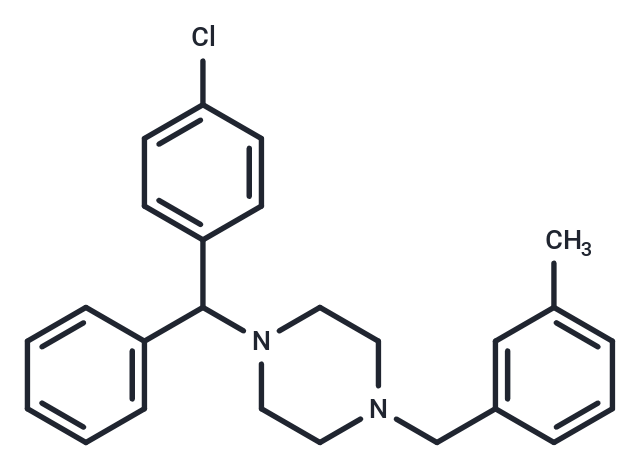Shopping Cart
Remove All Your shopping cart is currently empty
Your shopping cart is currently empty
Meclizine, also known as Meclozine, is a piperazine class H1 antagonist with antihistamine properties that inhibits the interaction of histamine at H1 receptors reversibly. It serves as an effective anti-motion sickness agent, able to cross the blood-brain barrier. Additionally, Meclizine acts as an agonist ligand for the mouse constitutive androstane receptor (CAR) and an inverse agonist for human CAR, making it useful in research on polyQ toxicity disorders, including Huntington's disease.

| Pack Size | Price | USA Warehouse | Global Warehouse | Quantity |
|---|---|---|---|---|
| 1 mg | $195 | In Stock | In Stock | |
| 5 mg | $449 | In Stock | In Stock | |
| 10 mg | $659 | In Stock | In Stock | |
| 25 mg | $987 | - | In Stock | |
| 50 mg | $1,390 | - | In Stock | |
| 100 mg | $1,880 | - | In Stock |
| Description | Meclizine, also known as Meclozine, is a piperazine class H1 antagonist with antihistamine properties that inhibits the interaction of histamine at H1 receptors reversibly. It serves as an effective anti-motion sickness agent, able to cross the blood-brain barrier. Additionally, Meclizine acts as an agonist ligand for the mouse constitutive androstane receptor (CAR) and an inverse agonist for human CAR, making it useful in research on polyQ toxicity disorders, including Huntington's disease. |
| In vitro | Meclizine (Meclozine; 50 μM; 24 hours) notably enhances the survival of ST Hdh cells following serum deprivation for 24 hours, mainly through the inhibition of apoptosis, as indicated by the reduction in caspase 3 and 7 cleavage. This protective effect is dose-dependent, displaying an EC50 of 17.3 μm, and achieving a maximal increase in cell survival by 218% compared to the control. Additionally, Meclizine offers protection to both mutant (ST HdhQ111/111) and wild-type (ST HdhQ7/7) striatal cells harboring polyglutamine (polyQ)-expanded huntingtin proteins against apoptosis induced by serum withdrawal. This was demonstrated in studies employing murine striatal cells, where treatment with a 50 μM concentration for 24 hours significantly increased cell survival, and Western blot analysis confirmed apoptosis suppression through caspase 3 and 7 cleavage analysis. |
| In vivo | Meclizine (also known as Meclozine; administered at doses ranging from 10-100 mg/kg intraperitoneally) has been shown to protect mice against kidney ischemia. Specifically, a pretreatment regimen of 100 mg/kg of Meclizine 17 or 24 hours before induced ischemia notably enhances kidney protection in the subject mice. The protective mechanism of Meclizine involves the direct inhibition of the Kennedy pathway responsible for phosphatidylethanolamine biosynthesis, which leads to a reduction in mitochondrial oxygen consumption, coupled with an upregulation of glycolysis. This study was conducted on 8-10 week old male C57BL/6 mice, with various dosages tested, revealing that the compound effectively shields these mice from kidney ischemia-reperfusion injury. |
| Synonyms | Meclozine |
| Molecular Weight | 390.95 |
| Formula | C25H27ClN2 |
| Cas No. | 569-65-3 |
| Smiles | Cc1cccc(CN2CCN(CC2)C(c2ccccc2)c2ccc(Cl)cc2)c1 |
| Relative Density. | 1.0318 g/cm3 (Estimated) |
| Storage | Pure form: -20°C for 3 years | In solvent: -80°C for 1 year | Shipping with blue ice/Shipping at ambient temperature. | ||||||||||||||||||||
| Solubility Information | DMSO: 4.5 mg/mL (11.51 mM), Sonication is recommended. | ||||||||||||||||||||
Solution Preparation Table | |||||||||||||||||||||
DMSO
| |||||||||||||||||||||
| Size | Quantity | Unit Price | Amount | Operation |
|---|

Copyright © 2015-2025 TargetMol Chemicals Inc. All Rights Reserved.